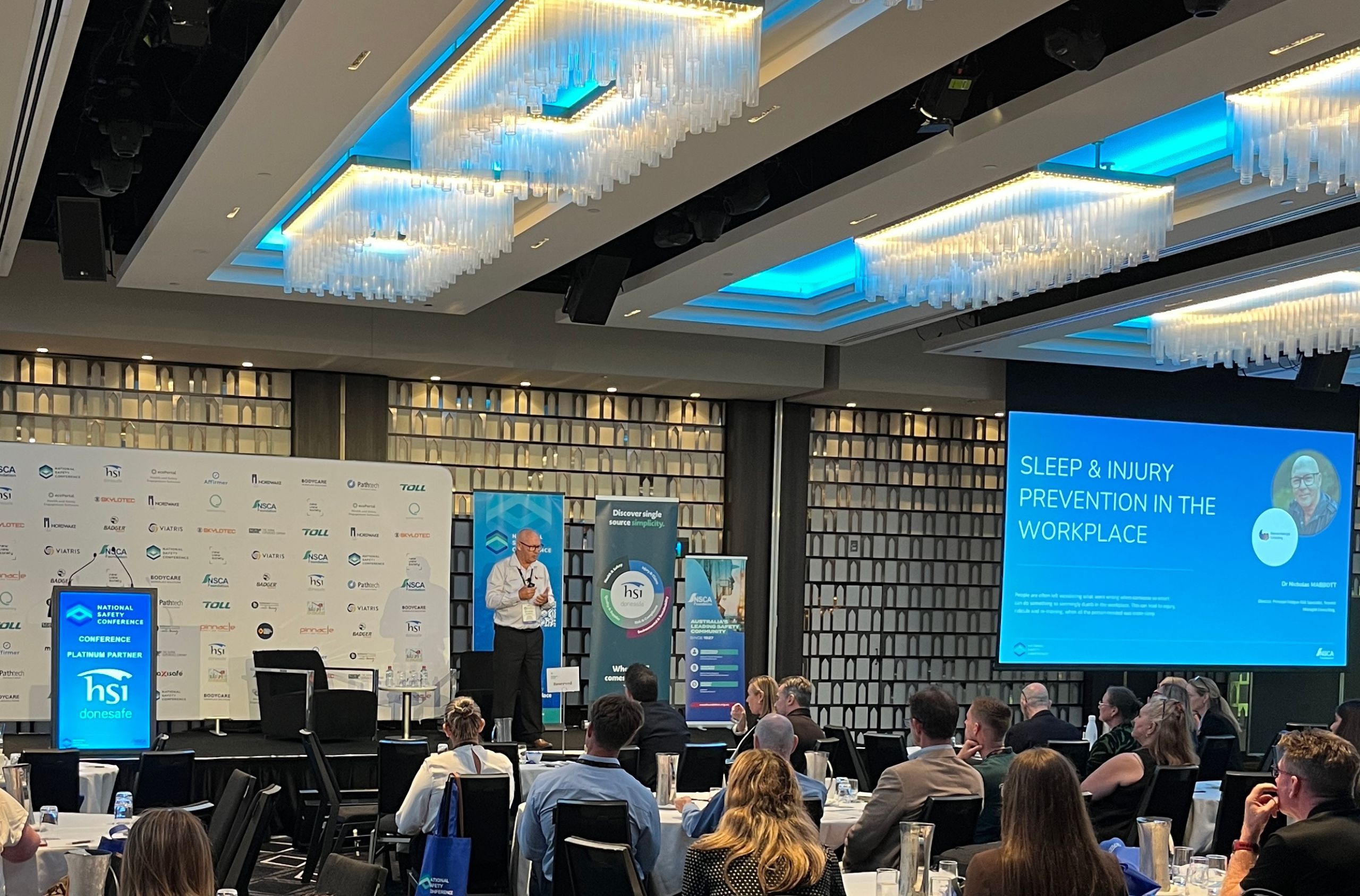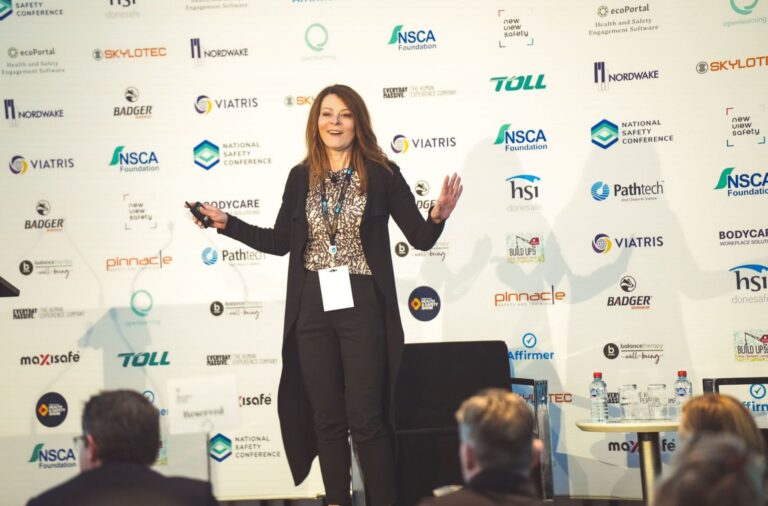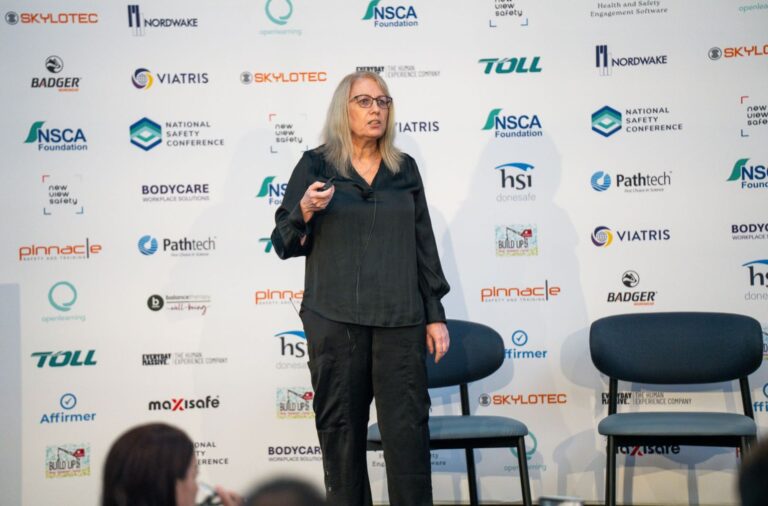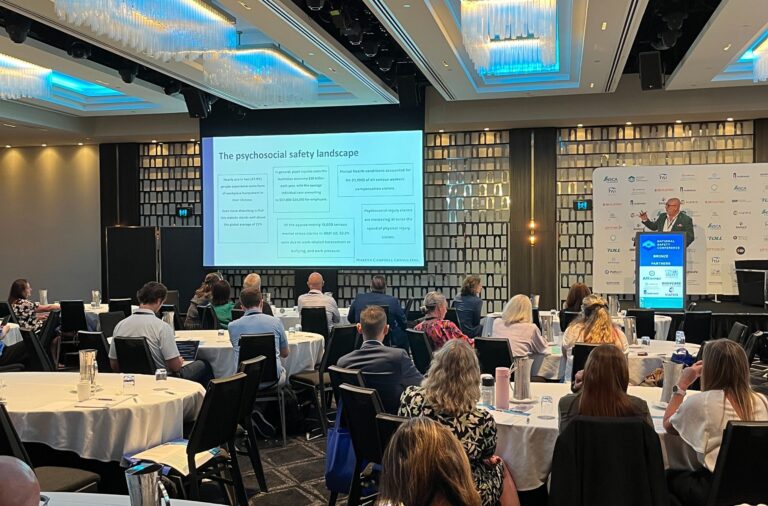
At the NSCA Foundation’s National Safety Conference in Sydney, fatigue specialist Dr. Nick Mabbott delivered one of the most confronting and compelling sessions of the event. With nearly 30 years investigating fatigue-related incidents — including 19 serious crashes, 15 of them fatal — his message was clear: if we’re serious about safety, we have to get serious about sleep.
“Every hour of sleep gives you two hours of brain energy the next day.”
It’s a simple equation with massive consequences. In a culture where long hours and minimal rest are often seen as a badge of honour, Dr. Mabbott is challenging safety leaders to shift the narrative. Because sleep — or the lack of it — isn’t just a personal health issue. It’s a systemic safety risk that’s hiding in plain sight.
“We need to improve sleep to improve safety — and that applies to everyone.”
Your Brain Runs on Sleep
Fatigue doesn’t just mean feeling tired. It alters brain function at a chemical level. As Dr. Mabbott explained, while your brain only makes up 2% of your body weight, it consumes roughly 20% of your daily energy — and that energy isn’t unlimited.
Every waking hour uses up brain fuel. As it depletes, your ability to make decisions, assess risk, communicate clearly, and respond quickly begins to erode. It happens gradually, and almost imperceptibly — which is exactly what makes it dangerous.
“The longer we’re awake, the dumber we get.”
In safety-critical industries, that degradation in cognitive function can lead to devastating outcomes. And the worst part? Most people don’t realise it’s happening until it’s too late.
“You won’t know when you’re falling asleep — but you do know when you’re drowsy.”
This distinction matters. Many workers — and managers — assume they can “push through” tiredness. But Dr. Mabbott draws a hard line: the moment you feel drowsy, your judgement is already compromised. The right time to stop is before fatigue sets in.
“Five or less hours of sleep? Please reconsider driving or going to work.”
The Hidden Safety Rehearsal
While most safety programs focus on training, compliance, and behaviors, Dr. Mabbott highlighted a lesser-known — but critical — function of sleep: safety rehearsal.
“You rehearse safety outcomes in your sleep. It’s your brain’s way of getting ready.”
This insight reframes sleep as an active part of the safety cycle, not a passive one. When workers operate the same equipment, navigate familiar routes, or follow repeated procedures, their brains actually rehearse those scenarios during sleep. It’s a kind of behind-the-scenes processing that consolidates muscle memory, sharpens reflexes, and helps the body respond faster when something goes wrong.
When sleep is cut short, that rehearsal doesn’t happen. And over time, it shows up in slower response times, more mistakes, and higher incident rates — even among experienced workers.
Why Fatigue Risk Isn’t Evenly Spread
One of the most practical insights from Dr. Mabbott’s session was his emphasis on risk concentration. While most organisations assume fatigue risk is shared evenly across a workforce, that’s rarely the case.
“20% of your workforce may be responsible for 80% of your fatigue risk.”
This 80/20 principle shifts the way leaders should think about fatigue management. It’s not just about blanket policies — it’s about identifying and supporting high-risk individuals. Often, these are shift workers, those with long commutes, caregivers with interrupted sleep, or employees who unknowingly suffer from sleep disorders.
Understanding this imbalance is a game-changer. It enables targeted interventions — from sleep health education and fatigue risk screening to adjusted rosters or flexible start times — that can dramatically reduce overall risk without blanket measures.
A Simple Fix for Better Sleep
Improving sleep doesn’t always require complex programs or high-tech tools. Sometimes, it starts with one well-timed change.
“Your optimal bedtime is your wake-up time plus 16 hours and 10 minutes.”
This formula, shared by Dr. Mabbott, reflects the science of circadian rhythms. It creates a short five-minute window where your body is naturally primed to fall asleep quickly and deeply. Miss the window, and you may lie awake for hours. Hit it right, and you can improve sleep quality without changing your schedule dramatically.
In fact, in people sleeping more than seven hours a night, this approach has been shown to increase sleep quality by over 50%.
Sleep Deprivation is the Risk Your Systems Can’t Outrun
Fatigue risk is often treated as a downstream issue — something to be managed after it starts showing up in rosters, reports, or incidents. But Dr. Mabbott urges leaders to flip that thinking. Sleep is upstream prevention. It’s the foundation that supports all other safety controls.
“Sleep like a champion. Not like a baby — they wake up pooping themselves.”
Yes, it’s a memorable line — but also a critical mindset shift. Prioritising sleep isn’t about pampering your people. It’s about giving them the physiological foundation to make smart decisions, respond quickly, and stay safe on the job.
Dr. Mabbott’s final takeaway was simple, but powerful: every hour less of sleep adds complexity to your controls and increases your exposure to risk. The most effective — and human — intervention might just be the one happening outside of work hours.
“Because the simplest way to prevent harm — is to start with sleep.”
About Dr Nick Mabbott
Dr Nick Mabbott is the Director of Beyond Midnight Consulting, with over 25 years of experience in sleep and fatigue management. He has worked across industries such as transport, mining, and construction, providing tailored fatigue risk assessments and training. Nick’s research focuses on the impact of sleep quality and shift work on workplace safety, and he has authored nearly 60 publications. His work helps organisations reduce fatigue-related incidents by improving sleep management and understanding individual sleep needs.
Share:



